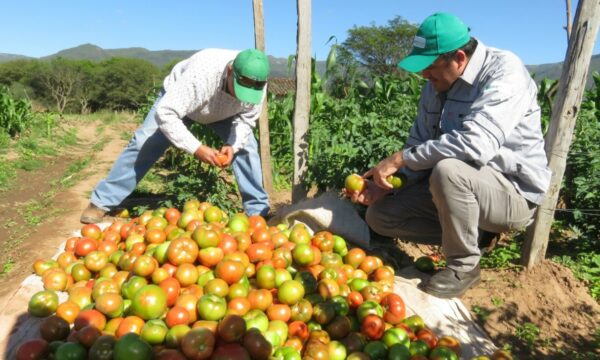Adapted from ‘Tomato leaf miner/ American leaf miner management in Agricultural production systems (Distribution, biology, damage and integrated management)’ written by Koppert Biological Systems.

Tuta damage to leaves and fruit
The tomato leaf miner, Tuta absoluta, is a devastating pest of tomato. Originating from Latin America, T. absoluta has spread via infested fruits and packaging material to Europe, North Africa and the Middle East. Given its potential for crop destruction and rapid reproduction, it quickly became a key pest of concern in East Africa. Its primary host is tomato, but it also affects potato, aubergine, beans and others.
Symptoms
Infestations of tomato can occur throughout the entire crop cycle. Feeding damage is caused by the young caterpillar stage (larvae) which feed on the leaves, forming irregular leaf mines which may later die. Inside these mines, both the caterpillars and their dark frass can be found. In case of serious infestation, leaves die off completely.
Larvae also create mines in the stems, affecting the plant’s development, and attack green fruit, opening them up to entry by diseases. The extent of infestation is partly dependent on the variety. Potential yield loss in tomatoes (quantity and quality) is significant and can reach up to 100% if the pest is not managed. On potato, mainly aerial parts are attacked. However, damage on tubers has also been reported.
Description
Larvae start out cream in colour with a characteristic dark head but become greenish to light pink as they develop. Adults are brown moths with silvery-grey scales and characteristic black spots on the wings.
Management

Trap used to catch Tuta adults
Tuta absoluta is a very challenging pest to control. Effectiveness of chemical control is limited as the insect is often protected in the leaf mines, and have a rapid capability to develop resistance to insecticides. Sex pheromone traps are used as an early detection tool. Mass trapping and ‘lure and kill’ pheromone applications are effective at mass capturing T. absoluta adults. IPM strategies are being further developed to achieve appropriate management of T. absoluta.
Biocontrol
- Predatory capsid bugs (Nesidiocorus tenuis and Macrolophus pygmaeus) which target eggs
- Bacillus thuringiensis – mainly targets larvae
Physical/ Mechanical tools
- Clean the area of old fruits and plants
- Close greenhouse ventilation openings with insect netting
- Use Horiver Tuta sticky traps for monitoring and mass trapping of adult moths
- Use Delta trap together with pheromones for scouting and monitoring the adult moths
- Use Tutasan water trap together with pheromones for mass trapping of the adult moths
Compatible insecticides
Azadiractin – Neem seed extract acts as contact and systemic insecticide against T. absoluta.
For more information, visit the Tuta absoluta Portal on CABI’s Invasive Species Compendium
4 Comments
Leave a Reply
Related News & Blogs
Overcoming gender barriers to tomato farming in Pakistan
A woman in her kitchen garden, Pakistan (©CABI) Tomato is an important crop in Pakistan – every year, the country produces 4.2 million tonnes of tomatoes. Growing them can be labour intensive. But research shows that tomato production has the potential…
23 May 2023





[…] via Managing Tuta absoluta in Agricultural production systems — The Plantwise Blog […]
after the leaves are destroyed,what are chances of fresh leaves
where can i get the traps in Uganda can you share their contacts details with me
Tough little buggers to manage, but I do so with minor loss by using pheromone traps and biological and plant-based sprays (Bt, neem oil, and some new fungal-based products). My fruit damage is about 5% of production.